
Golez, B. and Koudijs, P. (2025). Equity duration and predictability Journal of Financial Economics, 172:.
-
Affiliated author
-
Publication year2025
-
JournalJournal of Financial Economics
After 1945, expected returns have started to dominate the variation in equity price movements, leaving little room for expected dividend growth. An increase in equity duration can help explain this change. Expected returns vary more for payouts further into the future. Furthermore, because expected returns are more persistent than growth rates, they are more important for longer-duration assets. We provide empirical support for this explanation across three datasets: dividend strips, the long time series for the aggregate market, and the cross-section of stocks. A simple present value model with time-varying duration can largely explain the post-1945 dominance of expected returns.